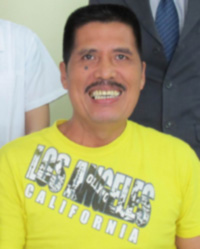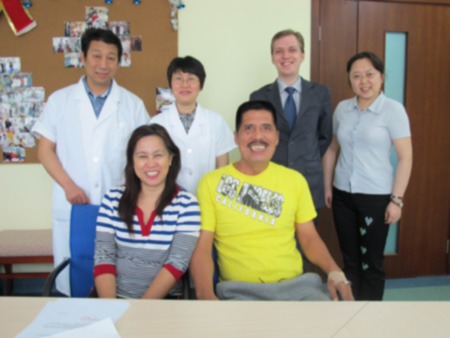Rey C. Tibayan - Parkinson (Philippines) Posted on June 19, 2012
Name: Rey C. Tibayan 
Sex: Male
Country: Philippines
Age: 52
Diagnoses: 1.Parkinson's disease 2. Hyperhomocysteinemia 3. Dyslipidemia
Admission Date: April 12, 2012
Days Admitted to Hospital: 29
Rey developed weakness in the left leg in 2008 and there were slight tremors. Rey did not pay attention to the symptoms and the symptoms gradually progressed. He began walking slower and the weakness spread to the left arm. He was diagnosed with Parkinson disease at the local hospital and was prescribed Sifrol for treatment, but the symptoms continued to progress. In 2010, the speed of the movements of the right leg and arm decreased. Rey also developed pain in the lower back. Simple daily tasks like eating, writing and dressing, became difficult and his speech became unclear. He was prescribed Madopar for treatment, but the condition was not brought under control. After being prescribed Sinemet in December 2011, his condition improved.
When Rey was admitted to our medical center, the movement of the arms and legs was slow, but the left leg and left arm were more adversely affected. While walking, the left foot would occasionally drag along the floor. Rey also had micrographia. He was basically able to take care of himself and only occasionally needed assistance. Rey also struggled with depression and anxiety.
Nervous System Examination:
Rey was alert, but his speech was slightly delayed. The memory, calculation ability and orientation were normal. There was facial masking. Both pupils were equal in size and round, the diameter was about 3.0mms. The movements of both eyeballs were flexible and both pupils were sensitive to light stimuli. The convergence ability of the eyes was disorder and the rapid blinking was discordant. The forehead wrinkle pattern was symmetrical. There were slight tremors in the genioglossus. The raising ability of the soft palate was normal. The uvula was centered. The head could be turned to both sides, but only slowly. There was muscle stiffness and a heavy feeling throughout the body. The left side of the body was more severe. The movements of the limbs were slow. There were mild tremors in the left lower limb. The shrugging strength of the left shoulder was level 3. The shrugging strength of the right shoulder was level 4. The muscle strength of the left limbs was level 5-. The muscle strength of the right limbs was level 5. The patient walks slower than normal and drags the left foot along the floor. The muscle tone of both upper limbs was normal. The muscle tone of both lower limbs was increased slightly. The bilateral biceps reflex, triceps reflex, radial periosteal reflex and patellar tendon reflex were normal. The bilateral Achilles tendon reflex and abdominal reflexes were not elicited. The bilateral Hoffmann's sign was negative. The bilateral Rossolimo's sign was negative. The bilateral sucking reflex was negative. The bilateral palm jaw reflex was negative. The bilateral Babinski's sign was negative. The deep, shallow, and epicritic sensations were normal. Both sides of the body were able to finish the finger-to-nose-test and digit opposition test in a stable manner. The left upper limb was slightly less coordinated then the right upper limb. The right side of the body could finish the rapid rotation test in a flexible manner. The left side of the body was less flexible with the rapid rotation test. The bilateral heel-knee-shin test was stable and accurate. The left lower limb was slightly slower than the right lower limb. The patient walks slower than normal and drags the left foot along the floor. The Romberg's sign was positive.
Treatment:
Rey received all of the relevant examinations and was diagnosed with Parkinson's disease. He received anti-Parkinson's medication and had the blood vessels expanded to increase the blood-supply, and he was given nerve nutrition. He also received treatment to get rid of the oxygen free radicals in the brain. This was combined with physical rehabilitation therapy.
Post-treatment:
The heavy feeling throughout the body and muscle rigidity has decreased from the time of admission. The pain in the neck, shoulders, waist and back has been alleviated. The facial masking is not as severe and he has some increased facial expressions. The rapid blinking is more coordinated. The bradykinesia of the limbs is not as severe. The muscle shrugging strength of both shoulders is level 5. The muscle strength of all 4 limbs is now level 5. The left limbs are slightly more uncoordinated than the right limbs. All 4 limbs have more flexible movement than before. The left foot still drags along the floor when the patient walks, but it is not as severe. The muscle tone of all four limbs is normal. The bilateral Achilles tendon reflex can be elicited. The left side of the body has more flexible movement with the coordinated movement examination. The patient can turn around more quickly than before while walking.

